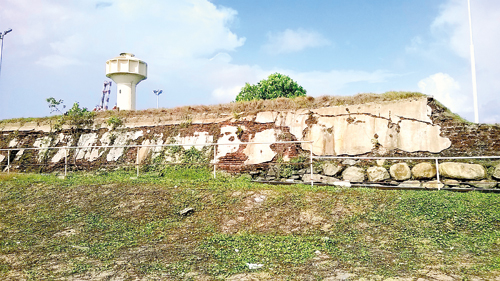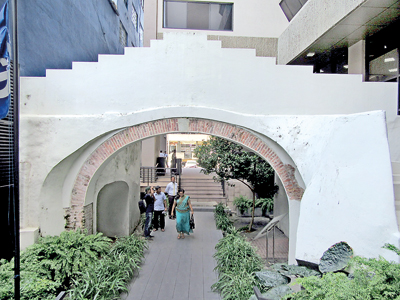Here a wall, there a warehouse: Remains of Colombo Fort

The Battenburg Battery used by the British until the Second World War
The Dutch Fort of Colombo was completed by the end of the 17th century and subjected to modifications over time. When Colombo fell to the British in 1796, the new owners continued to maintain the Dutch fortifications with very few modifications and in 1869 it was decided to demolish the fortifications for the improvement of the barracks of the Colombo Garrison. Only sections of the fortifications on the west and some parts in the north were left standing.
These over time had been broken up by the construction of various roads and private and public buildings in the city. Thus the remains of the Fort of Colombo which once would have existed collectively became separated as Colombo developed into its present form.
My research into the remains of the Fort of Colombo led me to identify seven locations in total belonging to the Dutch Fort. In an article titled ‘Rediscovering the ruins of Colombo Fort, (the Sunday Times, December 24, 2017 ) I identified three sections of the Dutch Fort within the Navy Headquarters – the entire Dan Briel bastion, the Postern Gate known as the ‘Slave porte’ and sections of the rampart from Dan Briel bastion to Amsterdam bastion. Here we explore the remaining four locations.
Delft Gateway
These four locations were identified on separate occasions. The first of these, the Delft Gateway can be found in the Commercial Bank premises down Bristol Street. This monument is protected by the Archaeological Department and is well maintained by the Commercial Bank. Anyone could freely visit the place.
The Delft Gate formed one of the three main entrances to the Dutch Fort of Colombo, the others being the Galle Gate in the south and the Water Gate in the harbour. This gate was located on the eastern ramparts between the bastions of Delft and Hoorn and opened up to the Pettah which was the residential area of the city known during the Dutch times as OudStad or Old City.
One entered the Delft Gate from the Pettah by crossing the moat using a drawbridge. A curved passageway to the right gave entrance to the Fort. On either side of the gate was one continuous building which housed the guards. The reason for the curved passageway was to avoid direct fire from the outside to the interior of the Fort in case of an attack.
What remains at present is the latter part of the interior of the Gate opening inside the Fort. The curved passageway can easily be traced. This is the only section of the remains of the Fort that is on the east of the fort if bisected from York Street.
Remains of the wall
of Battenburg Battery
The second location is the remains of the wall of Battenburg Battery which can be found inside the Harbour. This section is also known to the Archaeological Department. I came to know of this section through a Television documentary made a few years back and with the help of my cousin we gained access into the harbour to see it in 2014.
The Battenburg Battery was one of the two gun batteries built by the Dutch on the harbour arm that stretched into the sea. A gun battery is an arrangement of guns protected by a wall and does not contain any distinctive shape unlike the bastion and is built independently of the fort. The Dutch built these two batteries, Battenburg and Waterpass on the harbour arm to cover the approach from the sea and linked them to the main Fort through two lines of fortified warehouses. The Battenburg Battery was the only section of the Dutch Fort to be continuously used in warfare even after the demolition. This was used by the British as one of the four gun batteries which protected Colombo up until the Second World War when the British had installed six- inch breech loading coastal artillery on it.
All that remains now is a seaward section stretching for about 60 metres made up of kabook and bricks with relatively new cement plastering at certain sections. What is exposed is the side that would have been open to the sea, the area of which is now filled due to the expansion of the harbour, whereas the side of the wall facing the inside of the harbour is sealed by a concrete wall. Until recent times the naval guns, now found at the base of the Lighthouse, were fitted on Battenburg.
Fortified warehouse
The third remnant of the fortifications of the Dutch Fort of Colombo is the fortified warehouse. This is located at the end of Chaitya Road and now functions as the Maritime Museum. Linking the Fort proper with the gun batteries on the harbour arm were two lines of warehouses known as Pakhuizen which were double barrel vaults in design unique to the Dutch. It was here that all the commercial activities of the harbour took place as one of the main gates, the Water Gate was situated in the centre of the north warehouse which opened up to the jetty where the ships would dock. Apart from performing the warehouse function it served as a link to the Fort proper and the outer defences and was thus fortified with thick masonry so as to withstand bombardment from the sea.
What remains at present is the South Warehouse which is in a good state of preservation. Close examination would reveal the heavy masonry in its construction which could have withstood heavy bombardment. Its function is similar to that of the Galle Fort which is also the Maritime Archaeology Museum where the Warehouse forms part of the connecting rampart of the Fort.
The remains of the North Warehouse could barely be traced as it has been completely modified and now serves as the Harbour Master’s Office; but the double barrel vaulted roof could be seen in a certain section as well as traces of the old gate, which has now been sealed off. The stones which guarded the inner walls of the gate from the wheels of carts could still be seen. Interestingly the rock with the Portuguese coat of arms can be found in a small garden in front of this.

Curved passage of the Delft Gateway:One of the three main entrances to Colombo Fort
The wall from Enkhuysen Bastion and to Dan Briel Bastion
The final location of the remains of the Dutch Fort is a large section of the wall from Enkhuysen Bastion and to Dan Briel Bastion which is located behind the Junior Police Officers Mess down Chaitya Road. I came across this section of the rampart by tracing a plan of the Dutch Fort which I superimposed onto a present day satellite map. I had concluded that only six locations of the Fort remained and tracing this superimposed map I wished to identify the names of the buildings that occupied the ramparts and bastions for the research paper which I was writing. Coming to this section of the ramparts I walked one evening in early 2016 down Chaitya Road to find this particular building, which my map showed that the ramparts would have run behind. Noting that this was the building of the Junior Police Officers Mess I noticed something strange. In one corner of the building was a small canteen with a door opening to a courtyard at the back; I noticed an old wall. I thought for a second “could it be…” and walked through the canteen to the back to find to my astonishment the largest section of the ramparts I have yet seen!
The distinctive slope of the rampart was quite evident and it was about 10-12 feet in height and stretched for about 40 metres. It appears to have been plastered over several times as different plastering can be observed. There is also an interesting stone cut drain jutting out of the wall at a point.
These four locations and the three sections in the Navy Headquarters add up to seven locations which all belong to the Dutch Fort of Colombo. Discovering these old fortifications within the Fort of Colombo made me realize that even in living modern cities, ruins can be lost and forgotten. Of the seven locations, four locations remain unprotected monuments.


